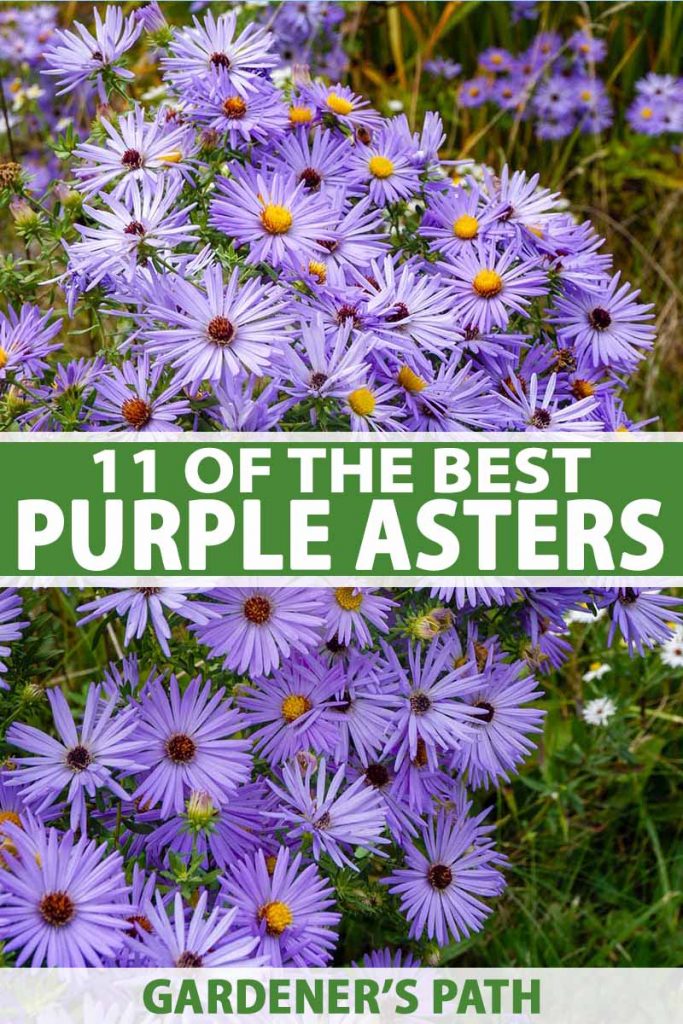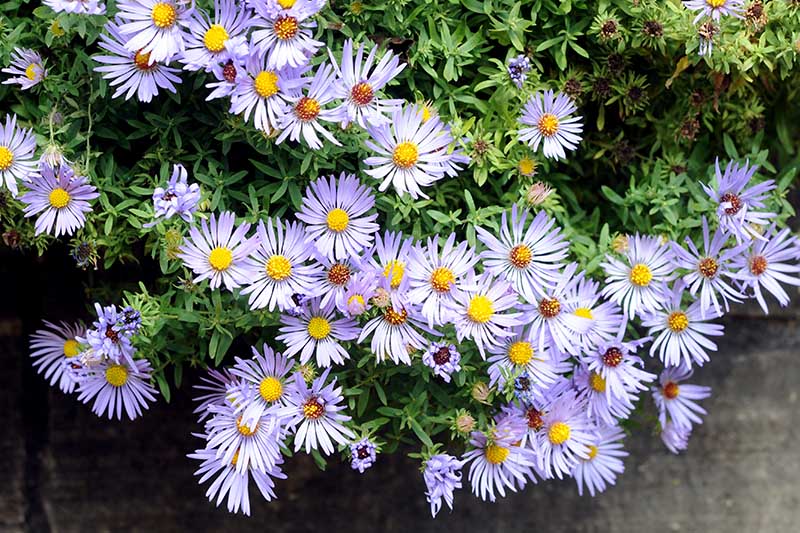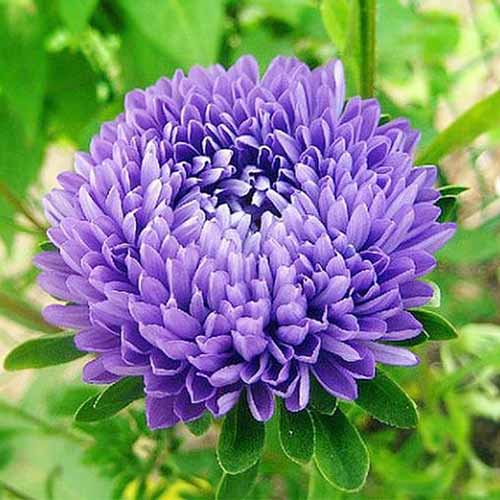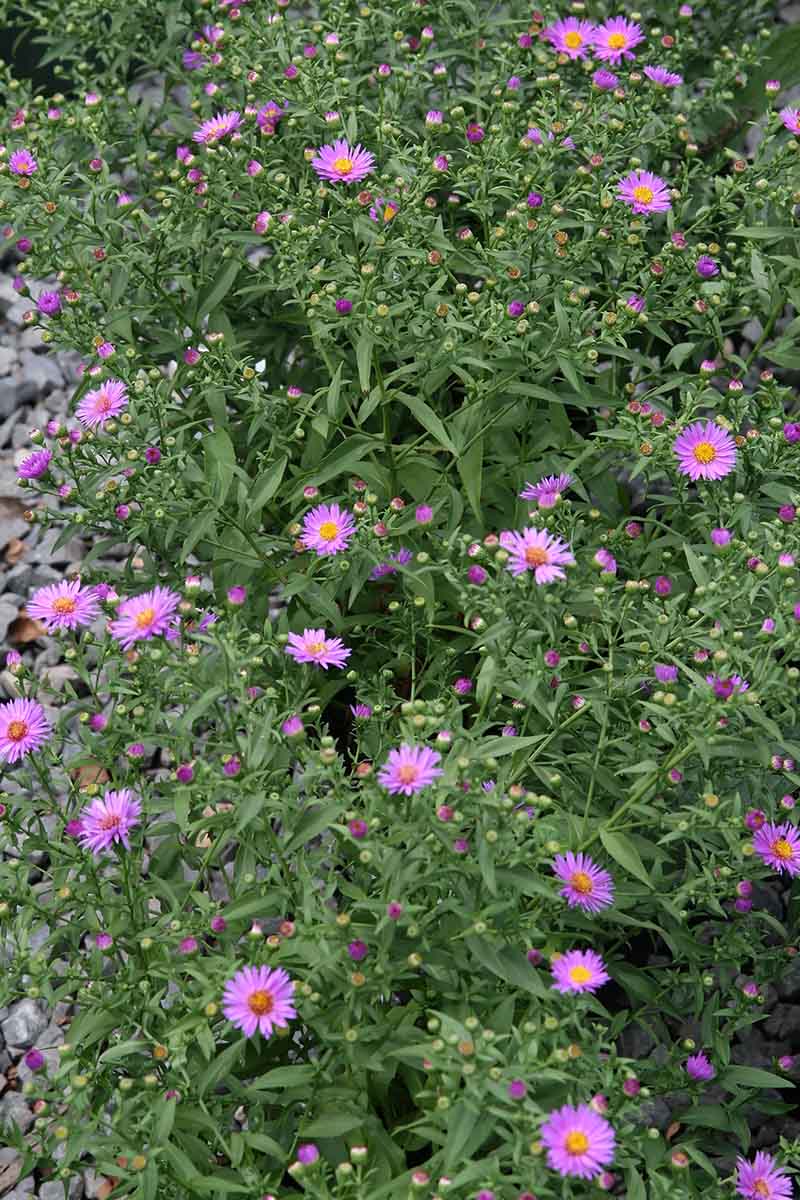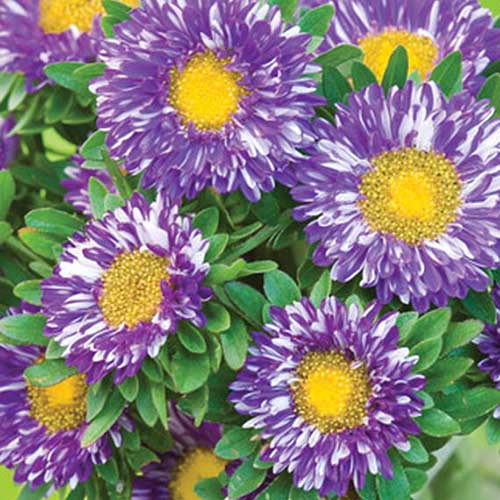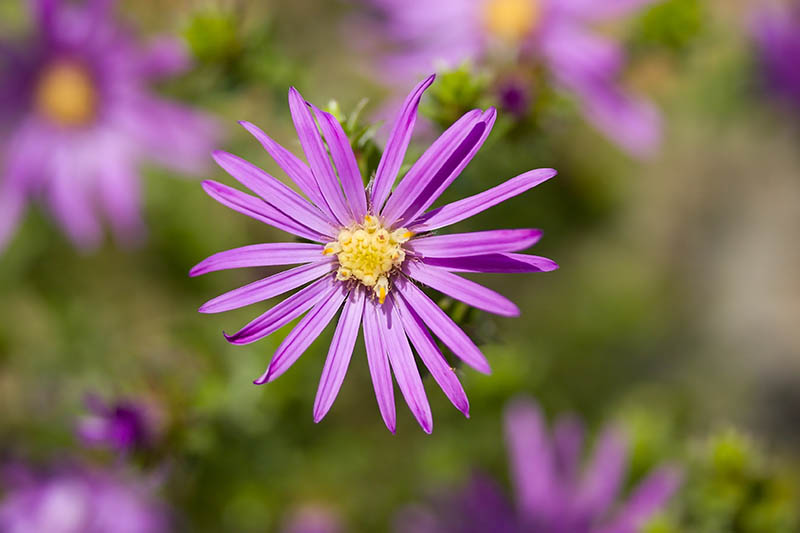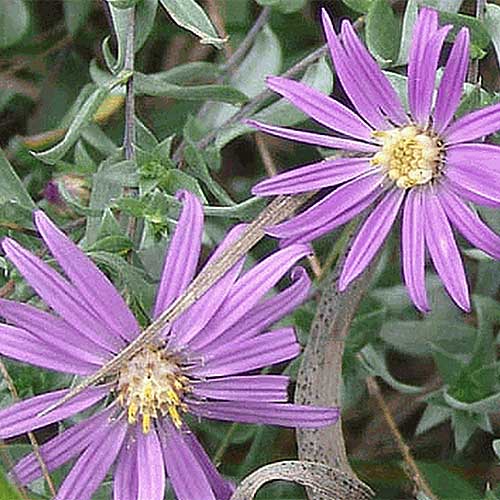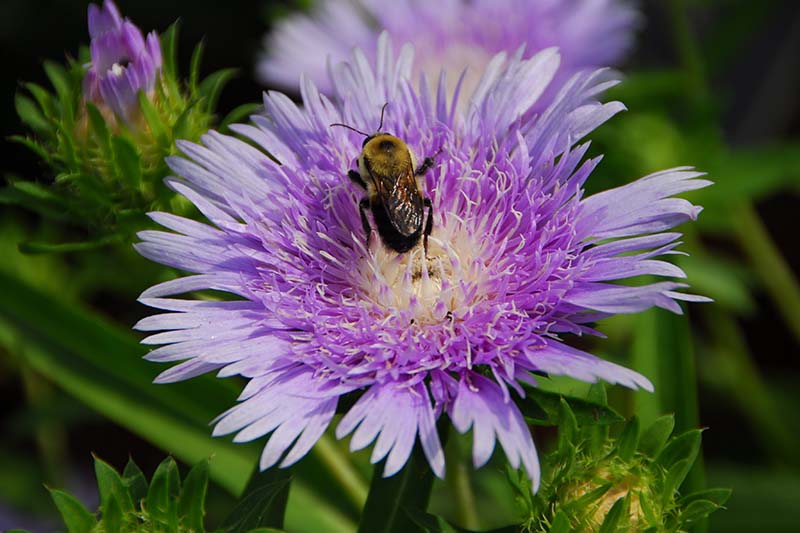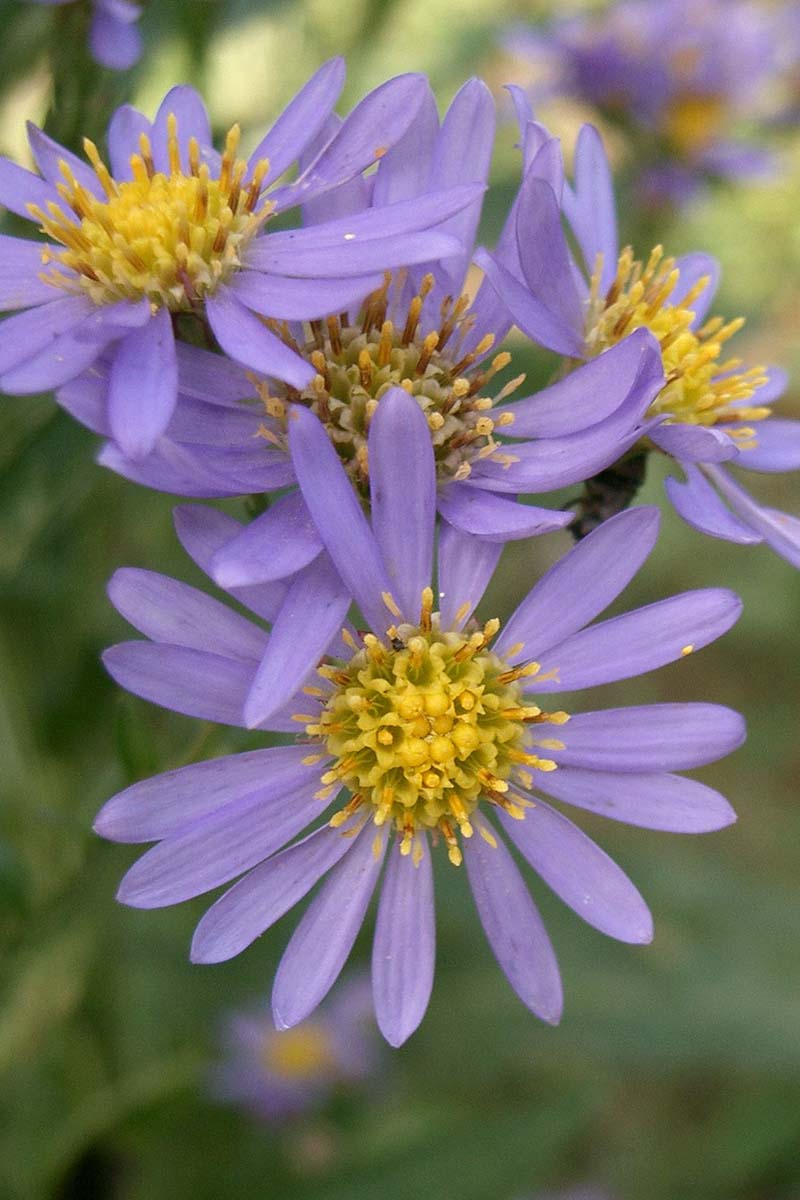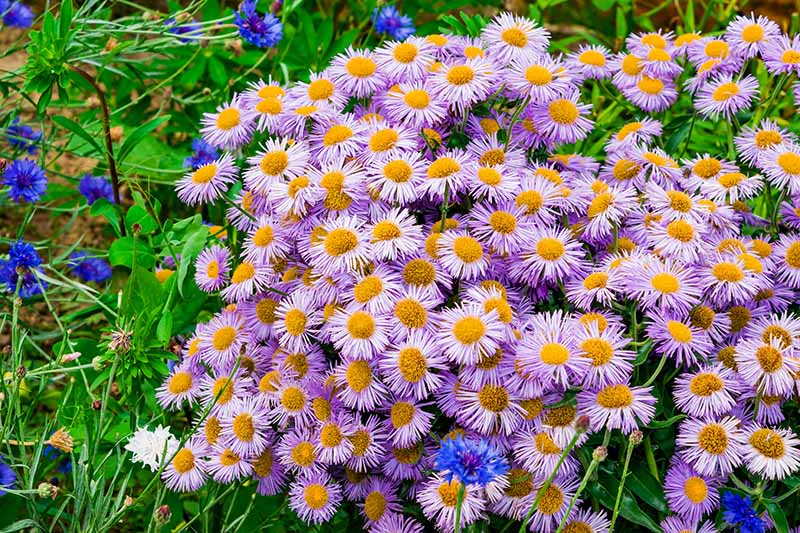It refers to a number of different species including China (Callistephus chinensis), New England (Symphyotrichum novi-belgii), and Tatarian (Aster tataricus). Perennial asters are suited to gardens in USDA Hardiness Zones 3 to 8, while annuals grow in any temperate zone. Most are transitional bloomers that brighten the landscape from late summer until the first frost. We link to vendors to help you find relevant products. If you buy from one of our links, we may earn a commission. In this article we introduce 11 of our favorite purple-hued asters. Here’s what’s in store: Get ready to wake up your gardens with a splash of eye-catching purple! If you’re new to growing asters, you need to know that perennials, especially native species, are aggressive wildflowers that are often considered weedy by folks who don’t care for their vigorous growth habits. However, there are steps you can take to prevent them from taking over the garden, and allow you to enjoy showy swaths of well-managed color. Here are 11 of the best purple asters to love.
1. Alpine
The Alpine species, Aster alpinus, is a perennial, suitable for Zones 4 to 7 that is native to Asia and Europe. It’s a little mountain gem that is scattered across the foothills, where it playfully nods in the breeze, heralding warm days ahead. This is an early bloomer that flowers from late spring or early summer to midsummer. It grows best in full sun, in soil of average quality that drains well. Mature dimensions are a petite eight to 12 inches tall and wide, making this a good choice for border edging, container gardening, fronts of beds, rock gardens, and window boxes. A. alpinus is available in shades of pink, purple, and white. One-inch flowers have a single layer of rays surrounding a prominent yellow center disk. There is one flower per stem. ‘Goliath’ In addition to the botanical species, there are a few noteworthy cultivars. ‘Happy End’ has lush semi-double lavender rays. ‘Dark Beauty’ (‘Dunkle Schöne’) is deep violet-blue. ‘Goliath’ is lavender-blue with three-inch blossoms and a mature height of 15 inches. Consult our guide to growing alpine asters for more information on cultivating this species.
2. Aromatic
The aromatic species, Symphyotrichum oblongifolium, is a native perennial, suitable for Zones 3 to 8. This species is found in the wild in two-thirds of the US from the Midwest to the Northeast, and intermittently across the South. S. oblongifolium This is a late summer to fall bloomer with a mounding growth habit. Plants thrive best in full sun, but tolerate part shade well. Soil of average quality is acceptable, provided it drains well. Mature dimensions are one to three feet tall with an equal spread. Compact and woody, this shrubby plant’s foliage gives off a fir-like aroma when crushed. The flowers have blue-purple rays surrounding a yellow center disk and measure one and a quarter inches across. Enjoy swaths of purple in middle to back of bed placements, stand-alone islands, large containers, and informal perimeter hedges. ‘Raydon’s Favorite’ is a cultivar with deeper toned rays and more flowers than the botanical species.
3. Dwarf Milady Lilac China
‘Dwarf Milady Lilac’ is a cultivar of the China aster, Callistephus chinensis. It is a non-native annual that thrives in Zones 3 to 9. C. chinensis ‘Dwarf Milady Lilac’ Plants flower from summer into fall in full sun to part shade, and enjoy organically-rich, well-draining soil. This little princess is a compact 10 inches tall and about eight inches wide at maturity – the perfect low-profile plant for containers on the patio, window boxes, and border edging. The Milady series is appreciated for having above average wilt-resistance. The flowers are excellent additions to cutting gardens, as they are long-lasting vase flowers. Lush and showy double-blooms measure three inches across, and have incurved lavender petals and an obscured center disk for a rich display.
4. Frikart’s
The Frikart’s species, Aster x frikartii, is a non-native perennial for Zones 5 to 10. It’s a hybrid of two species: the Italian A. amellus, and the Himalayan A. thomsonii. Note the warmer growing zones for this type. If you choose to cultivate it in areas with cold winters, choose a sheltered location and leave the spent foliage in place until the following spring. Bloom time is from midsummer into fall. Plants thrive in a full sun to part shade location. Soil of average quality is acceptable, provided it drains well. This plant has a mounding growth habit and is non-aggressive. It has been bred for exceptional drought tolerance and disease resistance. Mature heights are two to three feet tall, with a spread of one to one and a half feet. It’s quite at home in mixed beds and borders, as well as in butterfly and cottage gardens. The two-inch flowers have lavender to violet-blue rays surrounding yellow or orange center disks. Aster x frikartii ‘Mönch’ The ‘Mönch’ cultivar has a mature height of two to three feet and a spread of one to one and a half feet. Blossoms measure two inches across and have lavender-blue rays with yellow center disks. The ‘Jungfrau’ cultivar has a shorter stature, with a mature height and width of one and a half to two feet. Pretty lilac blooms measure two inches across.
5. Jewelaster Purple China
The ‘Jewelaster Purple’ cultivar of the China aster, C. chinensis, is a non-native annual with showy blossoms in rich jewel tones. It does best in Zones 3 to 9.
C. chinensis ‘Jewelaster Purple’ This is a semi-dwarf type with heights that reach approximately 16 inches. Bloom time is from late summer into fall. A full sun location is best, but this plant tolerates part shade. It requires organically-rich soil that drains well. The modest height makes it suited to the middle position in foundation beds, where it can hide the “legs” of taller plants behind it, and form a backdrop to low-profile flora in front. The sturdy mid-size stems and long-lasting blooms make this cultivar a great choice for the cutting garden. The flowers resemble chrysanthemums. They are fully double with incurved purple petals that obscure the center disks. Find ‘Jewelaster Purple’ seeds now from Eden Brothers in 1-ounce or 1/4-pound packages. Or you can other recommended china aster varieties here.
6. New England
The New England species, S. novae-angliae, is a native perennial for Zones 4 to 8. For residents of the Northeast, like me, this dynamic wildflower teeming with beneficial pollinators has marked the passing of summer since the days of the earliest Americans. Plants bloom from late summer to the first frost, creating a dramatic impact with masses of tiny blooms. Full sun to part shade and organically-rich, well-draining soil are required for an abundance of flowers. Mature dimensions for botanical species range from three to six feet tall and two to three feet wide. The greatest impact is achieved with mass plantings. Staking is usually required, as plants have a tendency to get quite “leggy.” The flowers in nature are pinkish-purple, but cultivated varieties may be blue, pink, purple, violet, or white.
S. novae-angliae ‘Purple Dome’ In addition to the botanical species, there are many cultivated varieties available with more compact growth habits and less of a tendency to spread. One outstanding cultivar is ‘Purple Dome.’ It reaches a manageable height of one to two feet with a spread of two to three feet, and produces even more flowers than the botanical species. The compact size makes it an ideal option for containers, as well as mid- to front-of-bed placements and mid-height borders. The semi-double blossoms consist of bright purple rays surrounding yellow center disks. Find ‘Purple Dome’ starter plants now from Nature Hills Nursery.
7. New York
The New York species, S. novi-belgii, is a native perennial suitable for Zones 4 to 8. S. novi-belgii Another Northeast classic, it’s similar to the New England species, but with thinner stems and without the hairy foliage typical of many asters. Bloom time is from late summer to frost. Mature heights are three to six feet with a spread of two to three feet. Staking may be necessary. Flowers measure about an inch in diameter and consist of purple rays surrounding yellow center disks. Cultivated varieties include blue, pink, purple, violet, and white options. ‘Wood’s Purple’ is an exceptional dwarf cultivar that reaches a manageable height and width of 12 to 18 inches, for use in containers, deep window boxes, beds, and borders.
8. Purple Burst China
‘Purple Burst’ is a cultivated variety of China aster, C. chinensis, that is suited to gardeners in Zones 3 to 9. It’s a non-native annual with showy multicolored blossoms.
C. chinensis ‘Purple Burst’ This is an early summer bloomer that does best in full sun with organically-rich, well-draining soil. Mature heights range from 18 to 24 inches with a spread of 12 inches. The striking semi-double blossoms have violet rays splashed with white and large yellow center disks, like handfuls of confetti for a summer celebration. Sow this compact, low-profile eye-catcher in containers as a stand-alone, or with a bright yellow early-blooming companion like coreopsis. Find ‘Purple Burst’ seeds now from Burpee in packages of 150.
9. Silky
The silky species, S. sericeum, is a native perennial that thrives Zones 4 to 8. Also known as the Western silver aster, it’s a wildflower of the Central Plains region, where it may be found in abundance on prairie lands.
This species prefers full sun and grows in dry to average soil that drains well. It has a compact growth habit, with a mature height and width of one to two feet. Flowers appear in late summer and continue into fall. Lavender to violet rays surrounding yellow disks measure about one and a quarter inches in diameter.
S. sericeum The name for this variety comes from the fine, silky hairs that cover the stems and leaves. This species has above average drought tolerance. It’s suited to xeriscaping, rock gardens, and areas of the garden that are especially dry or in danger of eroding. Find silky aster seeds from Everwilde Farms available at Walmart in jumbo packets
10. Stokes’
The Stokes’ species, Stokesia laevis, is a native suited to Zones 5 to 9 that hails from the Southeast, where it is an evergreen perennial. This is an early-flowering plant that blooms from late spring or early summer to midsummer. It grows in full sun with average to sandy, and even clay-like, soil that drains well. With deadheading, it is often possible to get a second flush of blooms in early fall. Plants tolerate part shade, and exhibit above average heat tolerance. Mature dimensions are a compact one to two feet tall, with a spread of one to one and a half feet, making it well-suited to container gardening, fronts of borders, window boxes, and mixed bed plantings. S. laevis This type resembles its cousin the bachelor’s button, Centaurea, more so than other asters. Blooms have feathery – rather than needle-like – rays, no center disk, and a diameter of two and a half inches. Cultivated varieties are available in blue, pink, purple, white, and yellow. ‘Honeysong Purple’ is a noteworthy cultivar that lives up to its name, attracting beneficial pollinators by the dozen to its royal shade of violet. ‘Peachie’s Pick’ is a cultivar with blue-violet blossoms that bloom from midsummer to fall, later than the botanical species and other varieties.
11. Tatarian
The Tatarian species, Aster tataricus, is a non-native perennial from Siberia that has been gathered for generations by herbal practitioners who believe in the curative properties of its roots. From the wild, this hardy plant made its way into the garden, where it is a coveted ornamental in Zones 3 to 9. Bloom time is from late summer until the first hard frost. For best results, grow A. tataricus in full sun, and average, well-draining soil. Botanical species may reach over six feet tall, and cultivated varieties between two and four feet. Plants spread to a width of two to three feet. The flowers are lavender-hued with a single row of upturned rays surrounding a prominent yellow center disk. They measure an inch across. A. tataricus ‘Jindai’ The ‘Jindai’ cultivar is a more compact version of the botanical species that measures three to four feet tall with a spread of two to three feet, making it a suitable back of bed anchor, or informal property perimeter hedge. See our guide to growing Tatarian aster for complete cultivation information.
Dynamic and Dependable
I like asters. They’re sturdy, reliable plants that produce masses of color. I know you’re going to check out the tips for managing perennial asters, but for now, here are four tips for success:
- Here in the Northeast we have our fair share of humidity, so not crowding plants is essential to ward off fungal conditions such as powdery mildew. Always be sure to take mature dimensions into account when planting, to allow for ample airflow.
- There’s a disease called aster yellows that is spread by leafhoppers. Keeping plants free of weeds can deter this pest.
- Some tall varieties get very “leggy,” and by the end of a hot summer, may lose their lower leaves. Stake the stems and place low-profile plants in the foreground to camouflage their bare-legged appearance.
- To curb spreading, be sure to deadhead spent blooms to limit self-sowing. Now you’re ready to pick your favorite purple-hued asters and add eye-catching color and rich texture to your outdoor living space. Will they be annual C. chinensis cultivars that offer the option of changing things up each year? Or are you in love with perennial wildflowers teeming with beneficial insects? Take out your garden planner and make room for the ever-popular aster today. If you enjoyed this article and want to learn more about growing asters, check out these guides next:
How to Grow and Care for Calico Aster in the Late Summer to Fall Garden 7 Tips for Pruning Perennial Asters How to Grow and Care for Sky Blue Aster 11 Perennial Aster Species for Summer’s Last Hurrah
